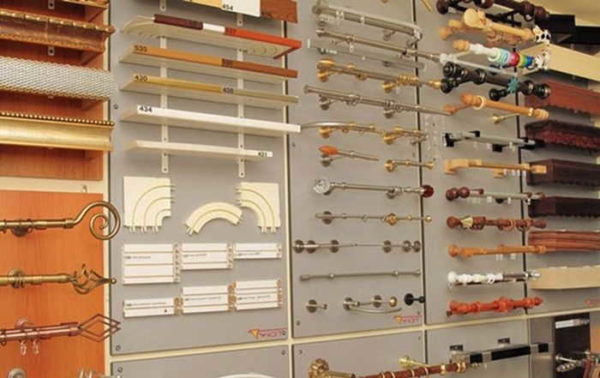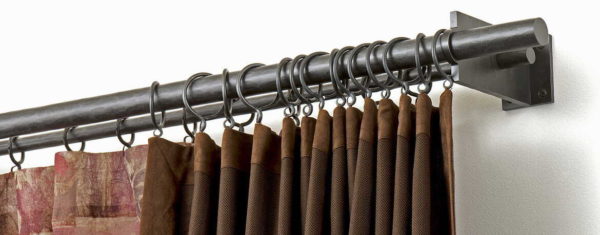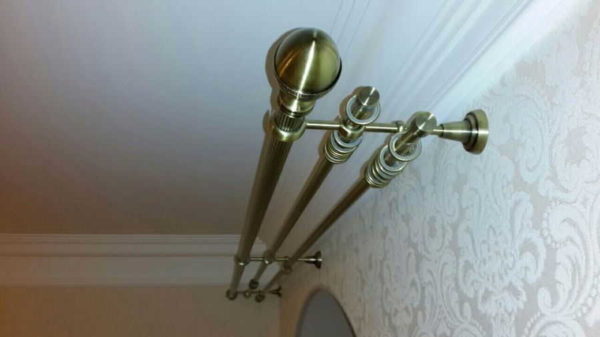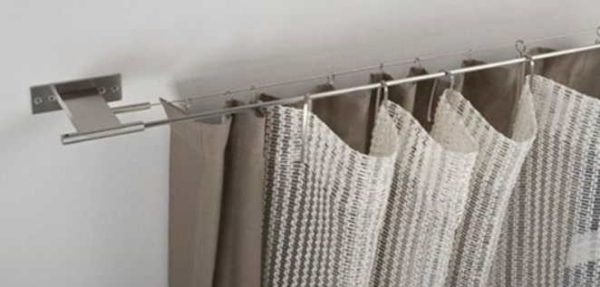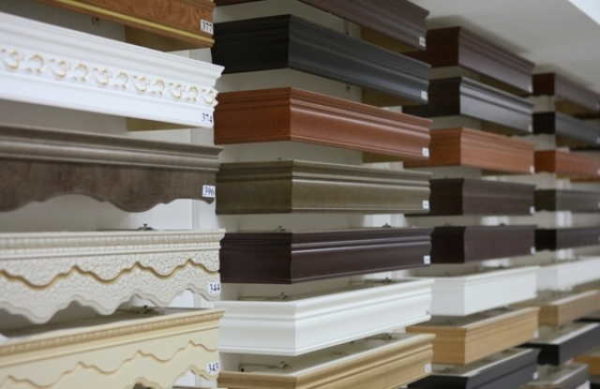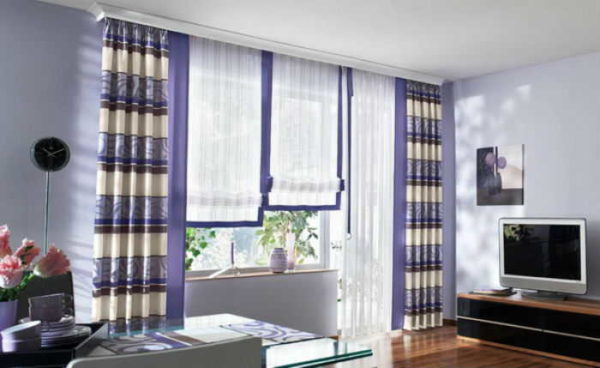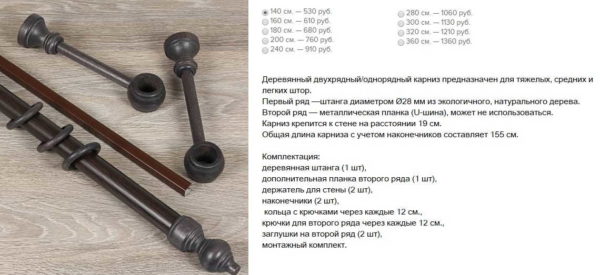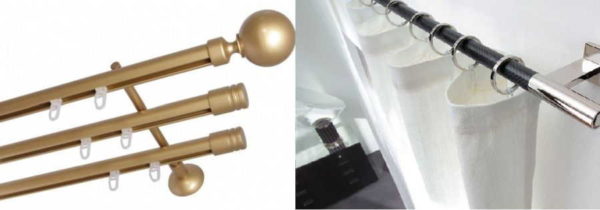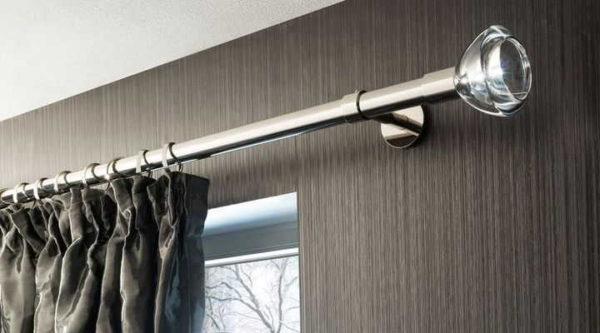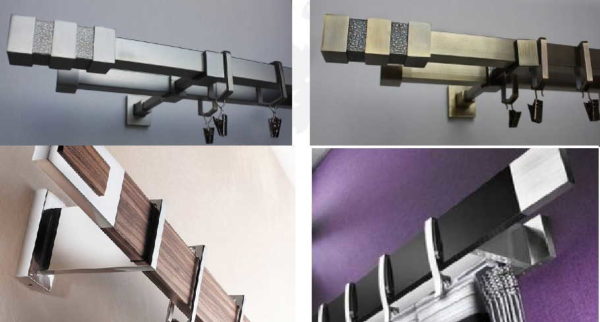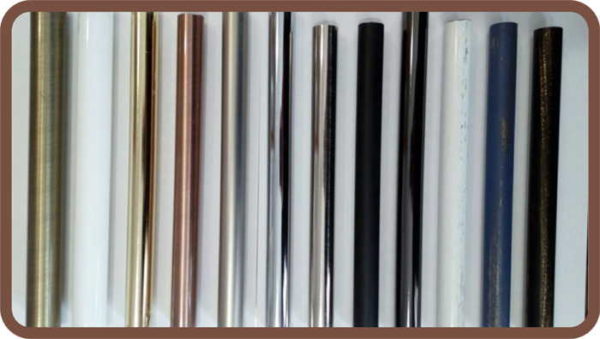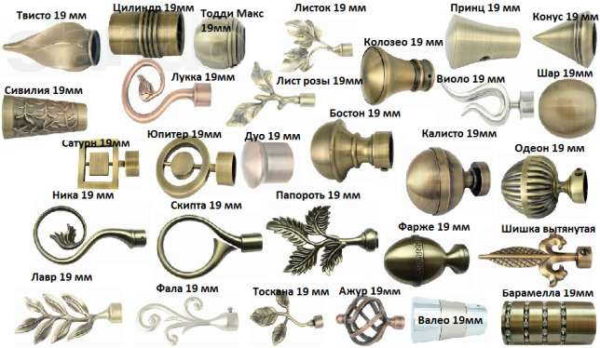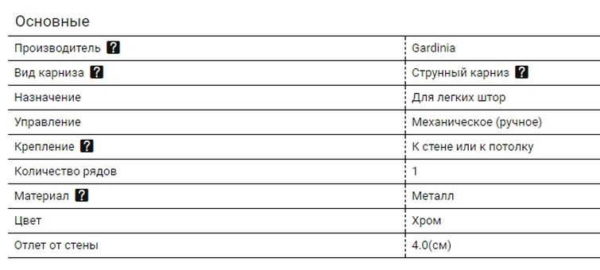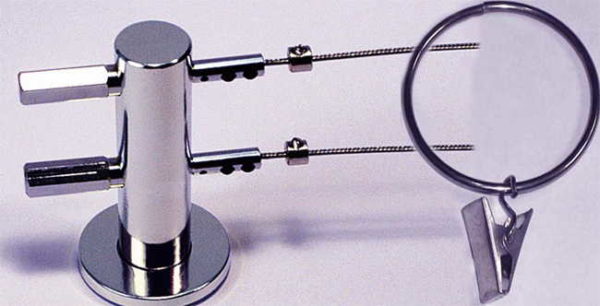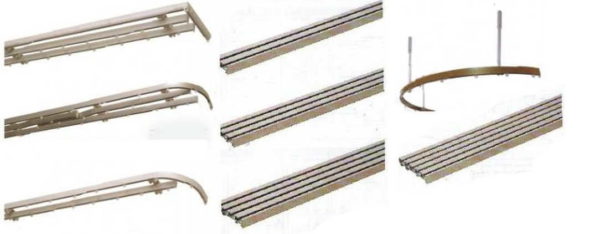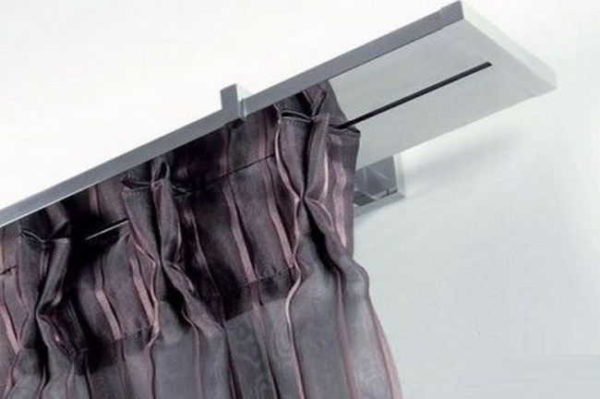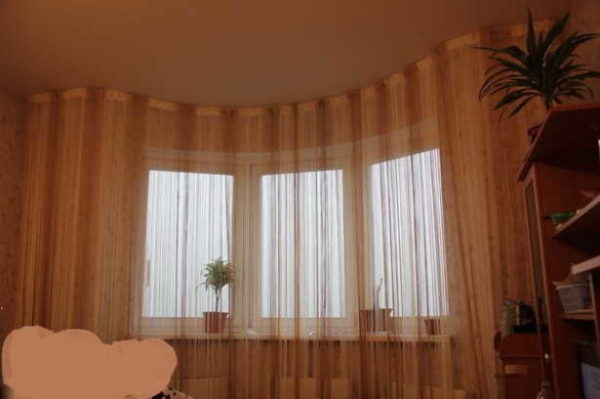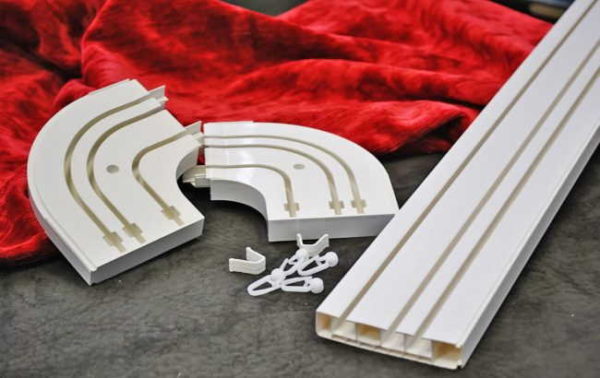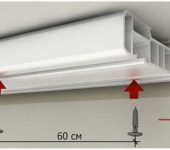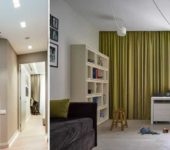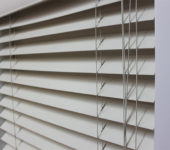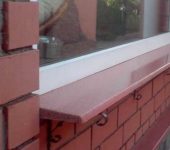How to choose curtain rods
Windows in residential and administrative premises are one of the most important parts that form the style of interior decoration. And their appearance is formed by curtains and cornices. In this part we will talk about what curtain rods can be.
The content of the article
Types, types, methods of installation
Even such a simple design as cornices has many types. Now it's not about the appearance, but about the design, the method of installation. In general, about the technical details.
By installation method
First of all, curtain rods differ in the way they are installed. There are wall and ceiling. The choice depends on your desire and the type of ceiling. The load-bearing capacity of the walls is usually sufficient to support the eaves, even under heavy curtains. Problems can only arise if the walls are made of aerated concrete or sheathed with plasterboard. But for such situations, there are standard solutions - the use of embedded, chemical anchors or special dowels.
With ceilings, situations are different. There are no problems with standard problems, but with tension or suspended ones you need to think in advance. In the case of tension ones, a ceiling cornice is usually used for curtains, and a structure with sufficient bearing capacity is erected to fasten the ceiling sheet, from a wooden bar or metal guides.
And it is not even possible to install a cornice on all suspended ceilings. You can attach it to drywall, but the drywall itself may not stand heavy curtains. This is only possible for light curtains like tulle. For heavier fabrics, wall cornices are used or ceiling cornices are attached, but to the ceiling itself.
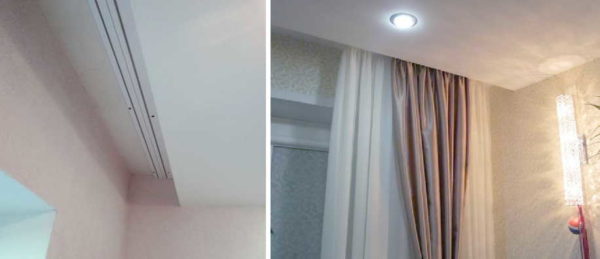
For stretch ceilings, string curtain rods are usually used for curtains that are mounted to the ceiling
Other types of false ceilings - plastic panels, armstrong etc. - generally not capable of carrying any extraneous loads. The best way out is, even during the renovation, before installing the ceiling, to install a mortgage - an additional profile or a wooden block, well fixed to the ceiling. Then attach the curtain rod to it.
We install fasteners reliable and often, on the assumption that it will have a constant load of several kilograms, plus sharp jerks when pulling / opening the curtains. So do not skimp on fasteners.
Type
In addition to the mounting method, curtain rods differ in shape. There are:
- Tubular. Usually they are round in cross section, but square ones also appeared. Traditional type of curtain rods, known for a long time. They also call them "round cornice". Their peculiarity is that they are part of the decor, therefore, when choosing, you also need to select a design. According to the method of fastening, there are wall and ceiling (rarely). There is also such a variety as rotary tubular cornices.
- Strings. They are a set of two brackets, between which several steel strings are pulled. They can be mounted both on walls and on the ceiling, but ceiling models are more common. String cornices are inexpensive. Unobtrusive, can be hidden or surface mounted.
- Profile or rail.For these cornices, a special profile is made, in which one, two or three grooves are made. Runners are inserted into these grooves, to which curtains and tulle are attached. If you need to open / close the curtains, pull on them and the sliders move along the groove. By the type of execution, profile curtains are:
- Tough. They are used as usual straight (linear) cornices.
- Soft. They are made from a special aluminum alloy that can be bent, but still tough enough to support the weight of the curtains. The second material from which flexible cornices are made is plastic. These profiles are used to make corner or bay window curtain rods.
- Baguette. Rather, it is a variation of all of the above. Baguette cornice for curtains has a front decorative strip (baguette), which covers the cornice itself, no matter what type they are: tubular, string or rail.
In general, these are all types of curtain rods. It is not so difficult to determine the type - your preferences and wishes are important. Then you will have to look for a model that is suitable specifically for your case, both in terms of technical characteristics (yeah, there are some), and in appearance.
Which is better
To say that some type of curtain rods is better, but some worse is wrong. Each is good in its own way, and each has its own disadvantages. It is necessary to select the type of curtain rod based on several criteria: the design of the room, the type of window and curtains, the desired effect.
For example, for laconic curtains without a lambrequin, any type of cornice, including tubular or rail, is suitable. Tubular are more suitable for rooms with high ceilings or, at least, where the distance from the top of the window to the ceiling is more than 20 cm, or better - 30 cm or more. Otherwise, they don't look very good.

It is necessary to choose a curtain rod for the interior, but do not forget about the technical details
Tubular curtains are not very suitable for curtains with lambrequins, as they stand out too much, in addition, this type of curtain in combination with pipes and rings does not look very good. For lambrequins, the rail or string version is more suitable. In this case, the cornice itself is hidden, so that its aesthetic value does not matter. For some styles, a baguette option will look better.
Curtain rods: we determine the parameters
First of all, you need to decide on the length of the cornice. The choice depends on whether you want to visually enlarge or reduce the window opening and the general illumination of the room. If you do not need to enlarge the window, there is plenty of light in the room, the curtain rods are taken either equal to the width of the window opening or a little more. The fact is that if you buy tubular curtain rods in a set, they come in standard lengths: 1.6 m, 2.0 m, 2.4 m, 3.0 m. Therefore, you have to take the nearest larger one. The way out is to look for shops in which pipes are sold per meter. There are those too.
If you need to let in as much light as possible into the room or you need to visually make it wider, when open, the curtains are placed on the adjacent wall on the right, left or on both sides. Depending on the density of the curtains and the number of folds, this requires from 30 to 60 cm on one or both sides. Therefore, to calculate the length of the curtain rods, 60 or 120 cm are added to the window width (more / less can be, depending on your desire). Then the task is to find the specified length of the cornice, or close to the found figure.
What curtains are for
Before you finally choose curtain rods, pay attention to what kind of fabrics they are intended for. The description is usually written "for light and medium" or "for light, medium and heavy curtains." The last option is universal, with proper installation it can withstand any loads.
If you have chosen metal curtain rods for curtains, you can not even look at the characteristics: they will withstand any. But with plastic and wood you need to be careful. There are quite a few models for medium curtains only.
Number of rods (pipes)
You also need to choose how many rods / pipes / lines you need curtain rods for. It depends on the type of curtain. They are:
- single;
- double;
- triple.
Single is used if only tulle or curtains are hung. Double - if both are required. Triple cornices are needed for models with lambrequins. With this, perhaps, everything is clear and problems can arise only if you decide to replace the curtains. If one string / pipe turns out to be superfluous - not a problem, and if there is a shortage, it is usually necessary to replace the cornice.
Tubular curtain rods: types, photos
They are made from metal, plastic and wood. Metal tubular cornices can be made of aluminum, bronze, steel and other alloys. There are round tubular cornices made of black metal or aluminum alloy, laminated with a thin film imitating wood species. These are the cheapest of this category.
Section: round or square
Basically, tubular curtain rods have a circular cross section. It's a classic. But there is also a square section with corresponding square "rings" for hanging curtains. They look stylish, fit for interiors decorated in accordance with modern trends: art deco, loft, minimalism.
But how convenient it is to use them, how well such "rings" will slide, this is the question. Everything can be good if the surfaces are perfectly sanded and fitted. If there are even the slightest irregularities ... It is easier in this regard with wooden curtain rods. They can be varnished. Then normal sliding is ensured. Although, no one bothers to varnish and metal ...
Sales forms
There are two forms of selling pipe curtain rods. The first one is a ready-made kit, which includes brackets, pipes, rings, tips. So they usually sell wooden or plastic curtain rods, some metal.
The second form is all separate. This is more typical for metal models. Buy a pipe of the required diameter and brackets. A thicker pipe is usually taken under the curtains - 22 mm or more, under the tulle - less. There are many different tips for decorating them. Different in price, shape ... For thin ones, like tulle, they take ordinary plugs, but for the first row, you can choose something more pretentious (if such a decoration fits the style of the room design).
With this form of sale, there are also several types of rings and clips for attaching curtains. They are also bought separately. After all, these rings are not always needed, since there are ways to hang curtains without additional fastening - on eyelets or hinges.
String cornices: installation methods and selection features
Nobody knows who came up with the idea of using metal wire for hanging curtains, but many people liked the idea. It is inexpensive, reliable, and fits into any interior. Only with heavy curtains can problems arise: the wire can bend under weight. Most string curtain rods are for light to medium. For heavy ones, you will have to look for another option.
String curtain rods can be wall and ceiling mounted. In any case, brackets are used, they just are of different types. When choosing, pay attention to the following parameters:
- Distance from the reference plane (ceiling or wall) at which the strings will be after installation.There are models for a baguette with a short distance, there are models with a large one, so that you can lower the curtains lower.
- Curtain rod length. If more than three meters is required, three brackets are needed - two at the edges and one in the middle.
- Number of strings. There are one, two and three rows.
- Strings diameter. For light fabrics, 2 mm is enough, for medium fabrics more is needed.
There are also string cornices for hidden and surface mounting. They differ in the decorativeness of the brackets. If the whole structure is hidden behind a baguette, choose the simplest and most unpretentious one. Most often this is a regular bracket with several holes. It will still be hidden, so you only need to worry about its strength.
Surface mounted string curtain rods have a more sophisticated look. Usually this polished metal of white or yellow color, can be with decorative elements. The principle of choice is a sign: in addition to technical parameters, it is selected according to the situation. Although the brackets are small, it is better if they do not conflict with the interior.
Profile or rail
One of the most interesting and diverse groups. Curtain rails can be made of metal or plastic. Plastic with good quality behave well in operation, but are suitable only for light fabrics.
Metallic ones are usually made from aluminum and alloys. In terms of reliability, they are good, but if the metal in the guide is poorly sanded, it can be problematic to draw or open the curtains. But this passes over time: the existing irregularities are smoothed out. If you want to speed up this process, you can arm yourself with very fine grain sandpaper for metal and even out all the errors. Should help.
Installation method
There are models of rail curtain rods for curtains mounted on the wall, there are - on the ceiling. Some can be mounted only on the wall or only on the ceiling, some have the option of choosing the installation method.
There is one more criterion for division: in appearance. There are profiles of a very simple type, which are intended for flush mounting. It can be mounted on a base ceiling if suspended or suspended, hidden behind a baguette (it does not matter when mounted on a wall or ceiling.
There are models for surface mounting. They are usually finished with a decorative strip. They are attached to the wall or ceiling with brackets. The number of brackets is determined by the length - up to 3 meters, only two are needed at the edges, more - three are already put.
Corner profile curtain rods
Rigid cornices are not suitable for bay windows or corner windows. If for corner windows it is still possible to dock two linear cornices, then such a trick does not work with bay windows. Their line bends smoothly, many short segments have to be joined, which looks, to put it mildly, "not very". That's why flexible cornices are needed.
They bend perfectly in the horizontal plane. In this case, it is possible to use one or two large curtains and not many narrow ones. There are three solutions for such windows:
- flexible aluminum profile for curtain rods;
- flexible plastic profile;
- prefabricated plastic.
When choosing, first of all, look for which curtains this profile is intended. Further, it should be taken into account that the prefabricated plastic corner cornice must be mounted strictly in one plane, otherwise the runners will get stuck at the joints. It is usually mounted on the ceiling, so it is desirable that it be without significant drops.

